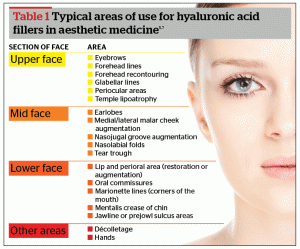The expanding use of soft tissue fillers in aesthetic medicine
Soft tissue fillers are now the second most commonly performed minimally-invasive procedure behind botulinum toxin injections9, 10. According to the American Society of Plastic Surgery (ASPS), approximately 2 million procedures were performed using soft tissue fillers in 2012, and the facial injectable market is estimated to be worth $1 billion in 20131, 11. Procedures using HA soft tissue fillers are predicted to increase in frequency by 8–12% per year in North America alone1,11. Drivers for this growth include greater awareness and acceptance of aesthetic medicine, improved accessibility to practitioners in the field, an ageing population, and the opportunity for individuals to increase their general wellbeing.
Sources of HA soft tissue fillers
HA soft tissue fillers are currently derived from three sources. The first source, the rooster comb of male chickens, is now largely an historic source; HA derived from this method is currently used in only a small number of US proprietary products designed for non‑aesthetic use6, 12.
Most HA used in aesthetic medicine today is derived from the bacterium Streptococcus equi subsp zooepidemicus (of various strains)5, 12. Streptococcus‑derived HA is well established in the worldwide aesthetic market, having been used for over two decades with catalogued efficacy and safety data. Even so, S. equi is considered a pathogen in horses, and there are a number of potential disadvantages of this source, such as trace residual endotoxin and lack of uniformity in HA molecular weight and strand length12, 13. For example, Restylane® (manufactured by Q-Med, a Galderma division, and distributed in the US by Medicis, a division of Valeant Pharmaceuticals) is a Streptococcus-derived HA product, which was initially associated with a hypersensitivity reaction frequency of 0.8% pre-200014. However, after improvements in the manufacturing process that led to a raw product containing less protein, this incidence decreased to 0.6% post-200014. To that end, alternative production sources have been explored to negate these potential disadvantages12.
The newest source of HA is from the bacterium Bacillus subtilis, first available in 2011 as Hyasis® (manufactured by Novozymes Biopharma DK A/S., Bagsvaerd, Denmark)5, 12. (Currently, Enhancement Medical, LLC, Wauwatosa, WI is manufacturing B. subtilis-derived HA injectable gel under the trade name Expression. As of January 2014, Expression has a Food and Drug Administration (FDA) indication for use as an intranasal splint, but it is used off‑label in aesthetic medicine with no official aesthetic indication.)
The B. subtilis-derived HA offers a number of bioprocessing advantages over Streptococcus-derived HA. In the Streptococcus-based process, HA is produced by the cells and surrounds the bacterial capsule. In order to liberate HA, the cells have to be physically disrupted: sonicated or homogenised, depending on the methodology. This results in a lack of uniformity in the resulting HA, so there is a wider range of molecular weights and chain lengths. When compared with the Bacillus process, which secretes HA, there is a narrower range of molecular weights (~850 MDa) and chain length, hence more uniformity in the final product.
Furthermore, in contrast to Streptococcus, which requires use of organic solvents to separate or extract HA from the bacterium cell surface, B. subtilis-derived HA is secreted directly into the medium from the host bacterium5. As such, the HA from B. subtilis can be separated from the host cell without the use of organic solvents. In order to physically separate the HA in the Streptococcus-derived process, organic solvents have to be used. In most of the methodologies reviewed, this requires a large volume of solvent. In the Bacillus-derived HA process, the elimination of the organic solvents reduced the costs and also increased the sustainability of the process because it is a 100% water-based process. The organic solvents are recovered in the Streptococcus process, but the solvents can affect the structure of the HA molecules. This can affect the bioprocessing of the final end product and steps must be taken to adjust for the presence of solvent, which could affect cross-linking and other properties. Whether this has a true effect in clinical translation is not known and will have to be further elucidated. Therefore, by eliminating organic solvents in the Bacillus-process, a ‘cleaner’ end product is the result.
There are a number of other source organisms (e.g. Agrobacterium sp, Escherichia coli, and Lactococcus lactis) from which HA can be derived, but many of these are restricted to laboratory-based primary research12. Currently, B. subtilis and S. equi are the only two organisms in use on a commercial scale12.
Bacillus subtilis: a microbial mini factory?
B. subtilis, first identified in 1835, was one of the first bacteria ever studied in microbiology (Figure 1). It is found naturally in soil, but also resides in the digestive tract of some animals15, 16. It is one of the most well characterised bacterial organisms in nature from a biotechnological perspective. The literature has evaluated its probiotic activity against the common digestive pathogens Helicobacter pylori and Enterobacteriaceae, which illustrate the varying dynamics of this organism16. Widely used in science and technology and having been granted ‘Generally Recognized As Safe’ (GRAS) status by the FDA, it is seen as an ideal host for production of HA6, 17.
The fermentation process using B. subtilis offers inherent bioprocessing advantages over Streptococcus‑derived HA (Figure 2). B. subtilis-derived HA is expressed from the cell into the fermentation environment; it is then separated without the use of organic solvents and spray-dried, making it a completely 100% water-based process. In contrast, in the Streptococcus processing model, the HA grows and surrounds the bacterial capsule and must be extracted using organic solvents (2-propanol and sodium acetate) to disrupt the cells to liberate HA6. This creates a number of processing difficulties, including a risk for the inclusion of trace bacterial endotoxins, cellular debris, and solvents when the HA is extracted, which limits its application in the biomedical field12. In contrast, B. subtilis-derived HA does not produce endotoxins6. In addition, the Bacillus model produces more homogenous strands of HA as compared with Streptococcus-derived HA.





